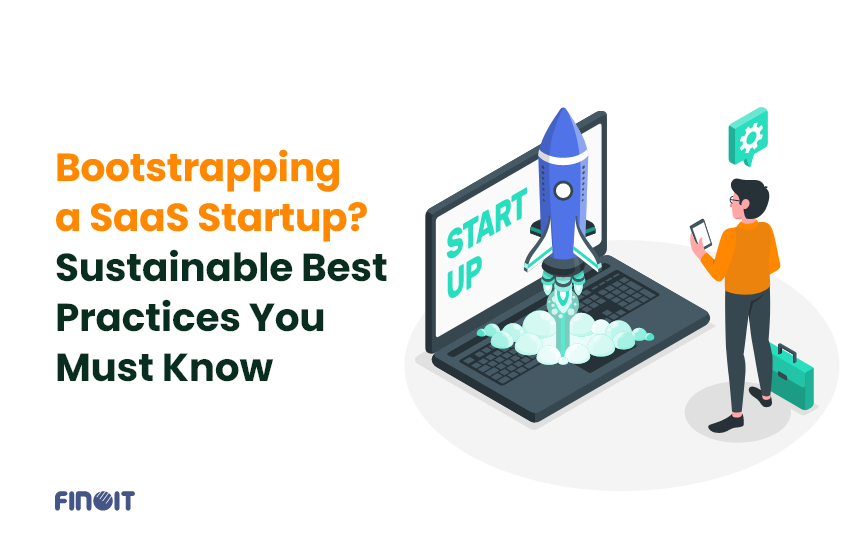Bootstrapping a SaaS Startup? Sustainable Best Practices You Must Know

Starting a business is a transformative journey that can have a meaningful impact on you and those around you. This journey can offer valuable experiences and opportunities that can lead to both wealth and wisdom, even if it ends up being a failure. However, funding your startup is one of the most challenging tasks you might face. Did you know that according to a study conducted on 500 entrepreneurs in 2022, 47% of startup failures were attributed to a lack of funding?
While some startups are lucky enough to get seed money from investors, many founders cannot secure seed funding or do not want to give away their equity. As a result, many entrepreneurs have to resort to “bootstrapping” or self-funding their businesses.
“Bootstrapping” originally comes from the phrase “to pull oneself up by one’s bootstraps,” a metaphorical expression indicating self-sufficiency and achieving success or improvement without external help. If you are a bootstrapping entrepreneur, you have sustained a business with minimal external resources or capital. Instead of relying on external funding sources, you utilize personal savings, revenue generated by the enterprise, and innovative cost-cutting strategies to fund operations, develop products, and expand the company. When bootstrapping, your main goal is to be efficient with limited capital, which you can achieve through various tried and tested strategies. Understanding Factors Influencing the Cost of SaaS Development is crucial in this context, as it helps you make informed decisions to optimize spending and maximize returns. This guide will discuss some sustainable practices and use cases that will elevate the success rate of your startup.
Best Practices for Sustaining Bootstrap SaaS Startups
The SaaS industry is snowballing, with a predicted increase of 21.2% over the next four years according to a study by CustomerThink. With low barriers to entry and the potential for multi-million-dollar acquisitions, SaaS can seem like a lucrative opportunity for all potential entrepreneurs. However, like any other startup business, the failure rate for SaaS companies is high. According to a study on startup sustainability, despite growth and funding, an estimated 92% of SaaS startups fail within three years, which concerns most C-suite executives. Hence, we have listed some best practices that can help industry players achieve long-term success:
1. Ensure You are Working on a Validated Business Concept
It’s always better to be safe than sorry, especially when it comes to starting your own business. Before jumping into the bootstrapping process, it’s crucial to conduct a thorough business validation to minimize the risk of failure. This not only helps you but also earns the trust of those who have invested in your idea. So, make sure you conduct both internal and external viability tests for your SaaS idea before proceeding.
Smoke tests are an effective way to validate SaaS products and enable pre-selling. Make sure that your product goes through multiple smoke tests at every stage, even before seeking partners or additional funding. By passing all the necessary smoke tests, you’ll have full confidence in your product, which increases the chance of pre-selling it.
2. Focusing on Customer Eccentric Approach/ Satisfaction
Develop a deep understanding of your target audience to grow your business. Engage with customers regularly to gather feedback, understand their pain points, and tailor your product or service to their needs. A satisfied customer base can be a powerful driver of organic growth. Improving SaaS customer experience can significantly enhance customer satisfaction and loyalty. Additionally, embrace an iterative approach to product development. Release minimum viable products (MVP) quickly and gather feedback to improve and refine your offerings continuously. This approach minimizes the risk of building features customers don’t need or want.
3. Focus on Making Strategic Partnership
Attracting key partnerships is essential for any business to succeed, including SaaS startups. Even if you are not a class A funded SaaS startup, you can still form strategic partnerships early on to help you gain market traction and cash flow. The key is to have a good and useful SaaS product that can benefit potential partners. For instance, Uber and Airbnb formed key partnerships with car manufacturers and landlords, respectively, even before coming to market, enabling them to offer unique value propositions to their customers, ultimately paving their way to success.
It is worth noting that partnerships need not be limited to other businesses or large companies in your primary market. You can also build partnerships with family members, other developers, and mentors who can offer the resources you need to succeed in your startup journey.
4. Adopt Leaner Operations and Smart Marketing Strategies
To ensure maximum profitability and sustainability, it is crucial to prioritize efficiency in every aspect of your business operations. This can be achieved by minimizing unnecessary expenses, negotiating cost-effective deals with suppliers, and streamlining workflows to achieve more with fewer resources.You can outsource software development for your startup as well, to reduce the cost of hiring and training developers. Additionally, it is recommended to utilize cost-effective marketing strategies that are tailored to your specific target audience. These strategies may include leveraging and optimizing content marketing, social media platforms, search engine optimization (SEO), and referral programs to reach potential customers without significant advertising costs. By implementing these measures, you can establish a solid foundation for your business and increase your chances of success in the long run.
5. Prioritize Revenue Generation and Cashflow
Achieving growth is undoubtedly important, but it’s crucial to prioritize profitability. Keep a close eye on your finances, understand your revenue streams, and strive to ensure that your business generates more revenue than it spends. This financial discipline is vital for the long-term sustainability of your business. Reasons, why startups fail, are common knowledge, but did you know your chances of succeeding while bootstrapping are even lower? According to research, approximately 90% of startups fail for various reasons, and the figure is close to 95% for those unable to attract funding in the early stages.
However, there’s some good news, too. As a bootstrapped business, you have more control over the factors contributing to your success or failure. With a focus on generating revenues and cash flow from day one, it’s easier to avoid failure. If you have confidence in your product, depend on early adopters, and aim to start selling as soon as possible, you’re more likely to fall into the 10% bracket of successful startups than a class-A funded startup.
6. Choose The Right Technology Stack
When developing an application, choosing the right technology stack is crucial. You can opt for affordable technologies that require advanced skills or more expensive proprietary infrastructure with better control and security. To enhance efficiency and tackle development challenges, consider leveraging SaaS software development services. These services offer specialized expertise and resources to help with technology selection and project support. Try to work with adaptable and agile methodologies, as the ability for startups to pivot and adapt to market changes is crucial, especially when resources are limited. Additionally, select popular programming languages like PHP, Ruby, Java, or Python, and use AWS for reliable, cost-effective infrastructure with storage, security, and elasticity.
Additionally, it’s essential to prioritize selecting experts over the latest technology. Remember that the best tool for your startup is the one your development team is already familiar with. Teaching someone a new technology is much more challenging than using an established, proven method. Therefore, choosing a technology and infrastructure that your team is comfortable with is critical. From the outset, plan for scalability, security, and performance. Ensure that SaaS databases securely separate user access and that your architecture is forward-thinking to prioritize high-speed page loading.
7. Hire a distributed team
When starting a new business, hiring employees and renting office space can be a significant expense. However, some successful companies like Basecamp, GrooveHQ, Zapier, and Buffer have opted to use remote teams from the outset and continued to do so even after becoming financially stable. From their example, we can learn that it is essential to hire slowly and carefully while paying attention to people’s values.
Employees should be dedicated to the company’s success, possess excellent interpersonal and communication skills, be self-motivated, and be comfortable working from home or a coffee shop. Continuous learning and upskilling are more cost-effective than hiring new skill sets, and should be encouraged within the team. Additionally, it is crucial to cultivate a company culture and foster team spirit. Buffer, for example, is a bootstrapped SaaS company that works remotely most of the time, meeting only three times a year for a week or two. Although time zone differences might be a concern for some startups, Buffer views them as an advantage. According to Joel Gascoigne, a co-founder and CEO of Buffer:
“We have almost a million users and we reply to 50% of emails within 1 hour and 75% within 6 hours. We do this with a Happiness Hero team of just 3, and we couldn’t achieve this level of service without being spread across multiple time zones. Time zones are a huge help for our development cycle too – with engineers in the US, UK, and Asia, we literally never stop coding.”
8. Adopt Sustainable Business Practices
Sustainability in business entails adopting various practices to minimize environmental impact, promote ethical operations and encourage social responsibility. Incorporating sustainable practices goes beyond profitability and requires making conscious choices that positively impact the planet, society, and the long-term viability of the business.
As a SaaS startup, there are several ways to embrace sustainable business practices. One way is to reduce your carbon footprint by adopting eco-friendly practices in your day-to-day operations. This can involve using renewable energy sources, implementing energy-efficient technologies in your office, minimizing waste through recycling and proper disposal methods, and transitioning to digital processes to reduce paper usage. Another way is to embrace sustainable technology solutions in your product development. Consider building features that promote eco-friendly practices among users or facilitate environmentally conscious behaviors in their operations. It is important to be transparent about your business practices, especially when it comes to environmental and social impacts. Establish clear sustainability goals, track progress towards them, and communicate these efforts to customers and stakeholders.
9. Align your Long-Term Vision with Short-term goals:
Having a long-term vision is crucial for defining the purpose and direction of your company. It outlines where you want to be in the future and helps you make informed decisions. While short-term goals may change with market trends or immediate needs, the long-term vision remains relatively stable. Aligning short-term decisions with this vision ensures that even small steps contribute to the larger purpose, avoiding contradictory actions. Therefore, it is important to maintain a clear long-term vision for your company while focusing on immediate goals. This will help you align your short-term decisions with the long-term vision and ensure consistency, avoiding short-sighted choices.
Bootstrapped Startups Success Stories
Approximately 75% to 85% of all new businesses are self-funded by their founders, making bootstrapping the most common way for startups to get off the ground says a study on bootstrap startups. Identifying companies that have been bootstrapped can sometimes be difficult. However, your local gas station, corner store, and favorite eatery are all examples of businesses that likely relied on founder capital. Let’s explore some unicorns that were initially bootstrapped.
· Go Pro:
Nick Woodman identified an opportunity to develop a distinctive camera for sports lovers. To get GoPro off the ground, he used his own savings and a small loan from his mother and persisted for almost a decade. Today, GoPro is a business worth billions of dollars, and its initial IPO was nearly $2 billion.
· Shopify:
Shopify, a bootstrapped tech company, adopted a strategy of slow growth and quick profits during its first decade of operations. Despite being almost two decades old, Shopify didn’t achieve instant success. Instead, its founders opted for organic growth by identifying a profitable market niche.
· Wayfair:
Wayfair managed to become a top player in the market without needing significant funding for almost nine years, thanks to its founder Niraj Shah’s savings and the company’s focus on getting the right people on board and having solid plans for growth.
· GitHub:
GitHub’s founder, Tom Preston-Werner, adopted a bootstrapping approach and invested only a few thousand dollars in the beginning. He prioritized immediate profitability to keep the business running smoothly. From the very first day of its launch, GitHub started charging for subscriptions, as Tom realized that he couldn’t rely solely on bootstrapping for years. As a result, he built the business model around generating revenue quickly.
Conclusion
As an entrepreneur, preparing for any situation when building your business from scratch through bootstrapping is crucial. The success of numerous bootstrapped companies we mentioned above shows that it’s achievable. It is also essential to keep looking for ways to improve your business processes and learn from mistakes, even without the benefit of hindsight or a large budget, if you want your business to sustain.
In the preceding section, we have outlined a set of effective strategies that can aid you in achieving long-lasting success. We hope that this write-up has provided you with the inspiration to take your next move. If you are unsure about how to initiate a SaaS enterprise and what measures to undertake at present, don’t worry. We are always available to address your queries and offer assistance in developing your dream project. Get in touch with Finoit today!


